An Insider's Guide to Santa Fe, One of America's Great Destinations

It’s always about the light, ethereal and crisp. Or as the artist Georgia O’Keeffe described it, a different kind of blue. It’s also about the fresh, high desert air, the smell of piñon pine trees, a flight of tequila, and the howl of a distant coyote. These are moments that fill the sensual abundance of days in New Mexico and more specifically in Santa Fe—one of America’s most unique cities, and one that's older than the country itself.
Santa Fe is the place where I take my soul to be rejuvenated, where people go and never want to leave. And now a new generation has discovered it as a creative center for artists, writers, sculptors, and more.
I had the “Santa Fe epiphany” in my twenties, when I went for a few days to visit some friends who had decamped from New York. I was running on the local Atalaya trail, reflecting on my visit, when I looked up at the aqua blue sky above the Sangre de Cristo Mountains and stopped to take it all in. I had never seen a sky like that before. A soft breeze rustled the aspen trees around me and the quietude of the moment gave me an emotional reaction that was hard to explain. My mind told me that I belonged there.
It took me a few decades to make that idea become a reality. Now, as a part-time resident for twenty years, I’ve gotten into the town’s fabric. But there is still so much more to discover.
What other city of 90,000 people can you think of that has 400 restaurants, more than 250 art galleries, nine museums, over a dozen annual festivals, hundreds of hiking trails, and day trips that include O’Keeffe’s Ghost Ranch, the Puye Cliff Dwellings, and the quirky, artsy town of Madrid on the Turquoise Trail, a national scenic route?
It’s no surprise to me that Santa Fe was just named the No. 1 travel destination in America by readers of Travel + Leisure magazine in its annual World’s Best Awards survey for 2025. Looks like the secret is out.
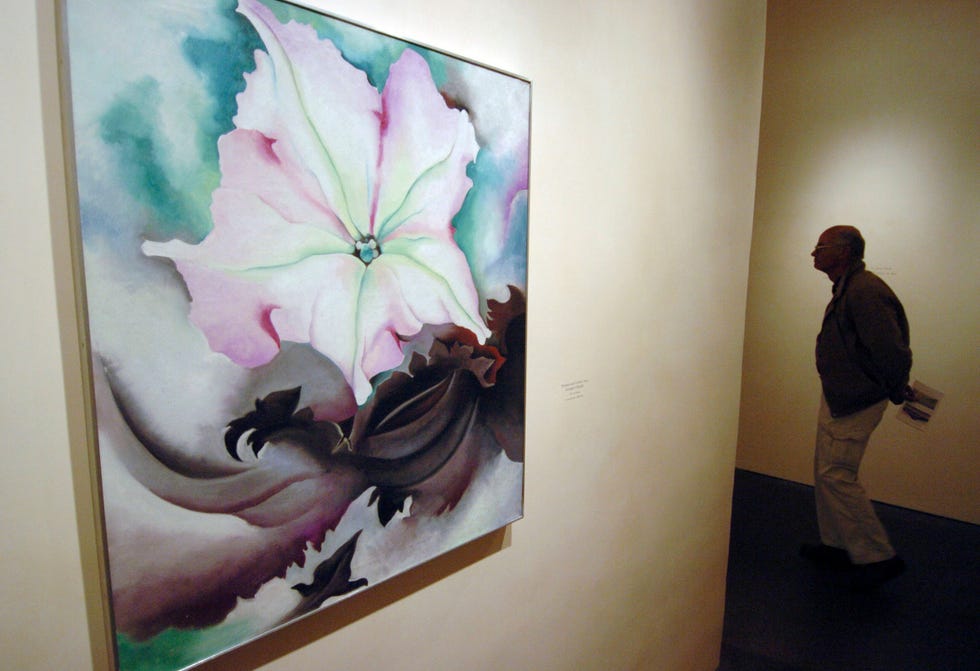
A painting by the artist and longtime Santa Fe resident Georgia O’keeffe on display at the Georgia O’keeffe Museum in town.
One of the town’s most beloved individuals is the legendary actress, Ali MacGraw, who went to live there after she lost her home in a Malibu fire in 1993 and never left. “There are incredible people here of every imaginable background and lifestyle, and we live in a landscape of powerful beauty,” MacGraw tells me, adding that, “It makes for a really vibrant and compassionate energy.”
MacGraw has become an engaged part of the local community and explained that she loves living there after two whole, other earlier lives. “It’s a refuge from the madness of the big cities I had always lived in, with ravishing surroundings, starlit nights and a huge feeling of nature all around. I have made wonderful friends here,” she says.
She isn't the only famous, accomplished person to feel the pull of Santa Fe. The actor Gene Hackman was a longtime resident until he and his wife died earlier this year. The designer Tom Ford was raised in Santa Fe and keeps a place there. And George R.R. Martin, the author of the book series A Song of Ice and Fire, which inspired the smash HBO television series Game of Thrones, is a big part of the community. Martin has opened a bookstore called Beastly Books and the cocktail bar Milk of the Poppy, and he restored the historic Jean Cocteau Cinema, where films, talks, and book signings are regular occurrences.
Santa Fe is a laid-back place. If you're drawn to the glitz of Aspen, the luxury shops of Palm Beach, or the nightlife of New Orleans, then Santa Fe probably isn’t for you. It’s a town that appeals to a different kind of person who is more interested in what you are reading or where you hiked that morning.
“I’m always amazed at the people I meet here,” says Owen Lipstein, co-founder of the lush, oversized Santa Fe Magazine. “Writers like Douglas Preston, the author of thirty-nine books, including The Lost City of the Monkey God; Hampton Sides, who wrote Blood and Thunder and others; painter Jean Paul Granillo; and filmmakers Kirk Ellis and Joan Tewkesbury all live and create here.”
Lipstein and his wife Maggie, a native of Santa Fe, moved here a few years ago from Hudson Valley, New York, to raise their daughter. Their love for the area and its people led them to become co-owners of the magazine, which is full of profiles of the town’s fascinating individuals.
I can relate. On a hiking trail, I met Lorenzo, who moved to Santa Fe after twenty-six years in Tuscany. At a local party, I connected with William Broyles, who once served as editor-in-chief of Newsweek before reinventing himself as a screenwriter and producer. He created multiple television series, wrote the movie Cast Away, and was nominated for an Oscar for Apollo 13.
It’s a place of extremes, but also a place that can embrace and hold you. You don’t have to conform to some kind of social construct.
My friends Yvonne Mendez, a former ballet dancer who is now a painter, and her husband Charles, who was a competitive race car driver and champion, as well as the chairman of the board and president of Sebring International, are part of my local crowd.
So was the late photographer Kurt Markus, who moved here from Montana with his wife Maria. He taught at Santa Fe Workshops, one of the top photography schools in the country for all types of photographers, and continued to build on his wide range of evocative images. His portfolio of American West modern cowboys is one of the largest in the world, but he also photographed for Esquire, Vanity Fair, and Outside magazines and many others, as well as shot global ad campaigns for fashion brands like Armani and Calvin Klein.
Creativity seems to be everywhere in this city, in one way shape or form. It’s part of the ethos of the town.
Joan Tewkesbury, the screenwriter for movies like Nashville and Thieves like Us, moved here in 1996. “It’s a place of extremes, but also a place that can embrace and hold you. People are accepted on their terms, whether a divine spiritual leader, a scientist, a shop owner, or an artist. You don’t have to conform to some kind of social construct,” she says.
Now eighty-nine, Tewksbury is the quintessential creator who lives here. She’s an advisor for the Sundance Institute, has published a new novel, Julio Robalo Opens the Door To His Mouth, and teaches a class she created for the Institute at various universities and for the Santa Fe Playhouse. The next generation of creators are her students and followers.
She is also artistic director with Kathleen Broyles for “The Los Luceros Milagra Initiative,” established by Robert Redford in New Mexico. Its purpose is to develop authentic stories by Native American and Hispanic writers.
One result has been the television series, “Dark Winds,” based on the Tony Hillerman novel, that is produced and directed by Chris Eyre with executive producers Robert Redford and George R.R. Martin. Filmed in the area, it brings to life the many layers of Navajo culture.
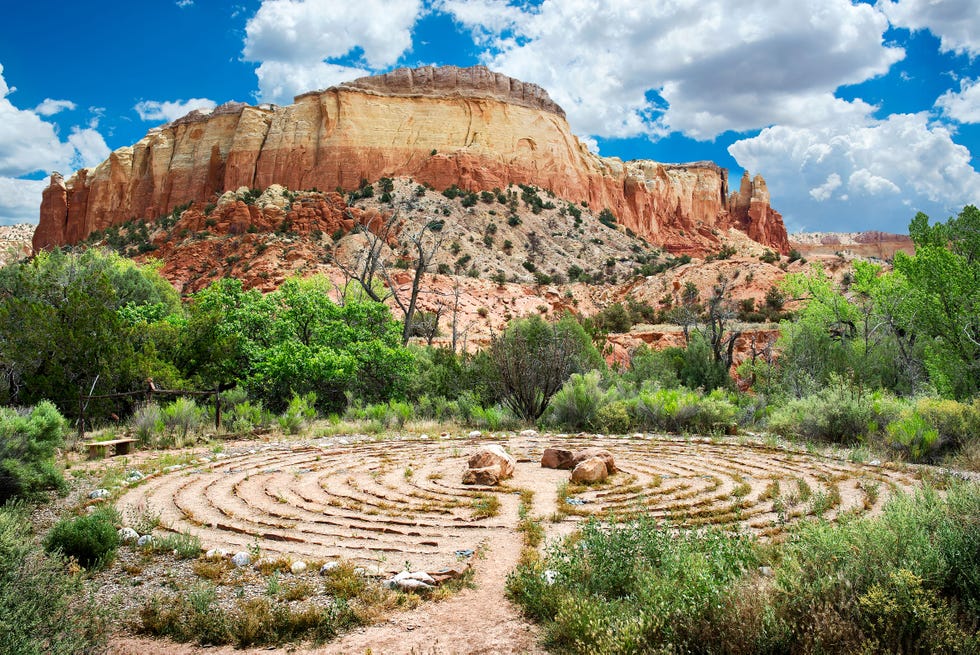
The labyrinth at Georgia O’Keeffe’s Ghost Ranch, a 21,000-acre retreat and education center on land that once belonged to the artist.
Go to Santa Fe with the intention of letting the city’s charms embrace you. There are layers and layers of history, art, and food culture to discover, all fueled by the blend of Native American, Spanish, and Anglo cultures which have melded there over hundreds of years. It’s a place that requires you to be hyper present to take it all in.
Humans have roamed this fertile area for more than twelve thousand years, but didn’t start settling until around 5,500 BC. Flash forward to 900 AD and that was the beginning of the great Native American cultures and pueblos that called this place home.
In 1610, the city that we know today was founded by Don Pedro de Peralta, the Spanish governor of New Mexico. Here, you can still see the oldest church in the United States, San Miguel; visit the oldest house in America; stop at Cristo Rey Church, the largest adobe structure in the country; and walk through the Palace of the Governors, the oldest continually inhabited public building in the U.S. But let’s not forget that places like the Taos Pueblo, a World Heritage Site built between the years 1000 and 1450 AD, is still home to members of the Taos pueblo tribe, one of nineteen other pueblos in the area, including the Acoma, Nambe, and Picuris.
When I get into town, my first order of business is to hit the hiking trails to breathe in the sagebrush, piñons, and junipers that thrive in the high desert.
My friend Emily Henry, one of the country’s top interior designers, who has her studio in Santa Fe, has been my muse for discovering the town, allowing me to cultivate what I call my “own private Santa Fe.” Raised in Taos, she knows the area well. In a story that I wrote for the New York Times called “Beyond Santa Fe,” she took me to places that are some of the hidden gems, although she insisted that I not write about some of them, as she said that they should only be known by those who live there.
But there are still many places to share. Start at the historic plaza. Make sure to have the fajitas or burritos at the El Molero Fajitas stand on the corner, and also visit the Indian craftspeople selling their creations. Go to the Margarita Bar in La Fonda (the restaurant La Plazuela is a must too). Walk up Canyon Road, established in 1100 AD (more on that later). Visit the Farmer’s Market on Saturday morning (show up hungry and with a bag to buy local produce, lavender, fresh honey and more from the more than 150 farmers and craftspeople there).
To get into the Santa Fe vibe, fly right into local Santa Fe Municipal Airport, newly renovated with easy access into town, a twenty-minute drive away versus the hour-long drive from Albuquerque with another twenty or more minutes to get a rental car. Flights from Denver and Dallas will get you there, and rental cars are right across the street from the adobe-style terminal building.
When I get into town, my first order of business is to hit the hiking trails to breathe in the sagebrush, piñons, and junipers that thrive in the high desert. Whether it is a walk or a run with Emily and our dogs, it never disappoints.
Given that Santa Fe is at an altitude of over 7,000 feet, most people chill out a bit on their first day to acclimatize. It’s important to drink lots of water, especially for the first day or two. An easy hike on lower Atalaya, Dorothy Stewart, or Dale Ball, where most of the locals go is a great way to start your visit.
There are hundreds of trails to hike, run, and climb. Our family loves Aspen Vista, especially in October where thousands of Aspen trees create a blanket of yellows and golds on the hills, as the season changes. You can hike to the top of Atalaya Mountain (three hours roundtrip) and explore the cliff dwellings of Bandolier.
My favorite spot of all is Kasha-Katuwe Tent Rocks National Park, an otherworldy collection of cone-shaped rock formations that's an hour drive southwest of Santa Fe. (Make sure to book this one in advance, as it has limited visits).
In the summer, make sure to take in the Santa Fe Indian Market, the largest Native American arts market in the world, where my friend Ric Charlie, a well-known Navajo jewelry designer, is always in residence. The Burning of Zozobra is a must-see cultural festival that has gone on for more than a hundred years. There are Pueblo feast days to experience, the Santa Fe Wine Festival, a literary festival and much more.

Flames engulf Zozobra, a 50-foot-tall marionette, during the 100th Annual Burning of Zozobra last year 2024. Zozobra represents anxiety and gloom, and has been burned every year since 1924 to alleviate the sorrow of the people of Santa Fe.
In the winter, head up to Ski Santa Fe, sixteen miles out of town. With a base elevation of 10,350 feet, there are a network of trails for every level of skier. Go to Ojo Caliente Mineral Spas, which is open year-round for an afternoon of soaking, hot tubs and massage. Ten Thousand Waves is closer into town for a day of self-care, as is the Ojo Spa Resorts.
Santa Fe is a city for walking, particularly to absorb the thriving art scene. For a first-time visitor, the sheer number of galleries can be a bit daunting, as there are so many to choose from throughout the town.
My best advice is to roam the neighborhoods and discover what you like. The Railyard District has more contemporary offerings, including SITE Santa Fe for new and established talent, as well as LewAllen Galleries, a Santa Fe mainstay. In other parts of town, check out Nedra Matteucci Galleries and Manitou, where I’m always looking for new work by one of my favorite artists, Miguel Martinez.
Canyon Road has the largest concentration of galleries, and you can spend a whole day strolling up its long winding hill, what Maggie Fine calls “arguably the oldest main street in America.”
Says Fine, “It was the road to the river valley for indigenous people over 1000 years ago. It was known as a pilgrimage route.”
Fine is the Founder and Director of the Canyon Road Summer Walk Series. Launched in 2024, its goal has been to bring people together through music, food and storytelling and to remind them of the deep history of this part of town. The five walks are the first Wednesday of the month starting in June with an extra one for Halloween, which drew over 6,000 festive costumed people in 2024.
There are nearly fifty hotels in the city. But when people ask for my advice, I usually suggest renting a house.
The Christmas Eve Farolita Walk, a long-held tradition is recognized as one of the most unique experiences anywhere, one that our family loves. We mingle with revelers who are singing carols around bonfires with tens of thousands of farolitas lighting up the pathway.
“Canyon Road has an amazing history,” says Fine. “It was the art colony started at El Zaguan in the 1920s that built its reputation as a major art road. Claude’s, one of the first gay bars in town was founded by Claude James, a lesbian whose father was the managing editor of the New York Times. She came here in the 1950s.”
Fine adds that, “Everyone from Bob Dylan to Pete Townsend stopped by, as everyone was welcome. The true energy of Santa Fe is that it is a place of coexistence.”
My artist friend Chris Richter, a local for twenty years was drawn to the city due to the huge community of artists, who support each other in their work. It’s the draw for the new generation of creative class that has discovered Santa Fe. “Over 40 percent of the city is made up of artists in one way or another,” he explains, adding that, “Such a high concentration of creators has been a great way for me to build my career.”
Aside from working in his studio, Richter hikes onto the trails and paints outdoors, inspired by the colors, textures, bark and plant materials in the hills around town to create his serene works of art.
Stan Natchez is always one of my first stops on the art circuit. A Shoshone and Tataviam Native American, his unique style of mixed media art inspired by Andy Warhol and Jasper Johns pays homage to his indigenous roots, while making social statements about the world around him.
“I view my work as contemporary Native American art with wit, humor and satire. While I use acrylics and oil, I integrate currency, pages, treaties and maps into my paintings,” he says. “Beadwork, an instrument of trade for my people, is also a part of my mixed media elements.”
Natchez is one of a few Native American artists with his own gallery. Another is Niman Fine Art, where Dan Naminga, a Hopi-Tewa member of the Hopi tribe and painter and sculptor shows his work, along with his artist sons Arlo and Michael.
The nine Santa Fe museums are rich with history, Indian Arts and Culture and International Folk Art and are in town and on Museum Hill. However, it is the Georgia O’Keefe Museum, which houses the world’s largest collection of her work that is one of the biggest draws for people who visit there.
In 2027, a new 54,000 square foot museum of O’Keeffe’s work will open. Influenced by the New Mexican landscapes and light, she lived in the area for nearly fifty years, creating her works of art and becoming one of the most recognizable female artists in the world.
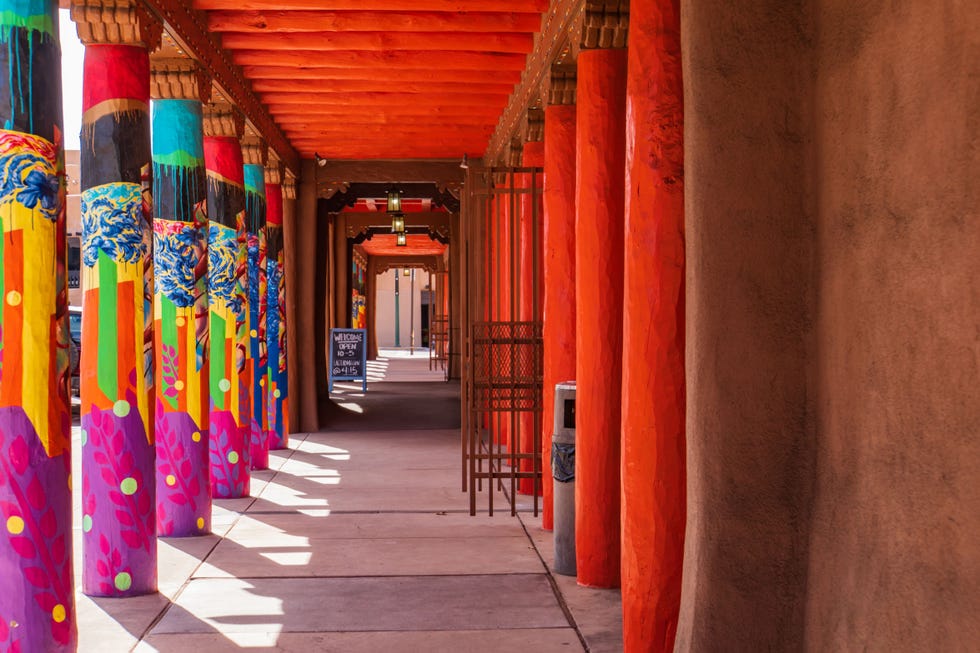
Painted columns on the plaza in downtown Santa Fe.
After a day of exploring galleries and museums, most people are ready to sample the prolific food scene in town. There’s every kind of food and there are always new players on the scene like Escondido or the Market Steer Steakhouse and its inviting Tack Room for drinks.
There are other long-established restaurants like The Compound and Santa Café, but when it comes to a special food experience, my top two go-to restaurants are Geronimo and Sazon.
Geronimo is owned and run by Chris Harvey, one of the longest-tenured restaurateurs in town. A charming and attentive host, he and his staff create an impeccable experience in one of the most inviting atmospheres anywhere in town.
The restaurant is housed in a structure that was built in 1756 and lived in by Geronimo Lopez and his family (hence the name). Harvey has owned the restaurant for thirty-three years and maintains a menu that is consistent and delicious. (He started working there as a waiter in college.)
“We are not the hip restaurant that changes its menu every two weeks,” says Harvey. “Seventy percent of our selections never change and every quarter we change 30 percent based on the season.”
Try the Tellicherry rubbed elk tenderloin with roasted garlic mashed potatoes, sugar snap peas with an applewood-smoked bacon, and creamy brandied mushroom sauce; the sweet chile and honey-grilled Mexican white prawns; or the green miso sea bass. Those and other dishes are prepared by Chef Sllin Cruz, who has been there ten years.
All of that can be paired with one of over 250 wine choices, high-end tequilas, or a collection of specialty cocktails, created by sommelier Shaun Adams, a twenty-year veteran of the place.
There are only two seatings a night, each with a two-and-a-half-hour window, so the experience is never rushed. With only twenty-six tables in the main house and twelve on the outside Portale, it feels more like a family gathering. It’s best to make a reservation at least a month in advance!
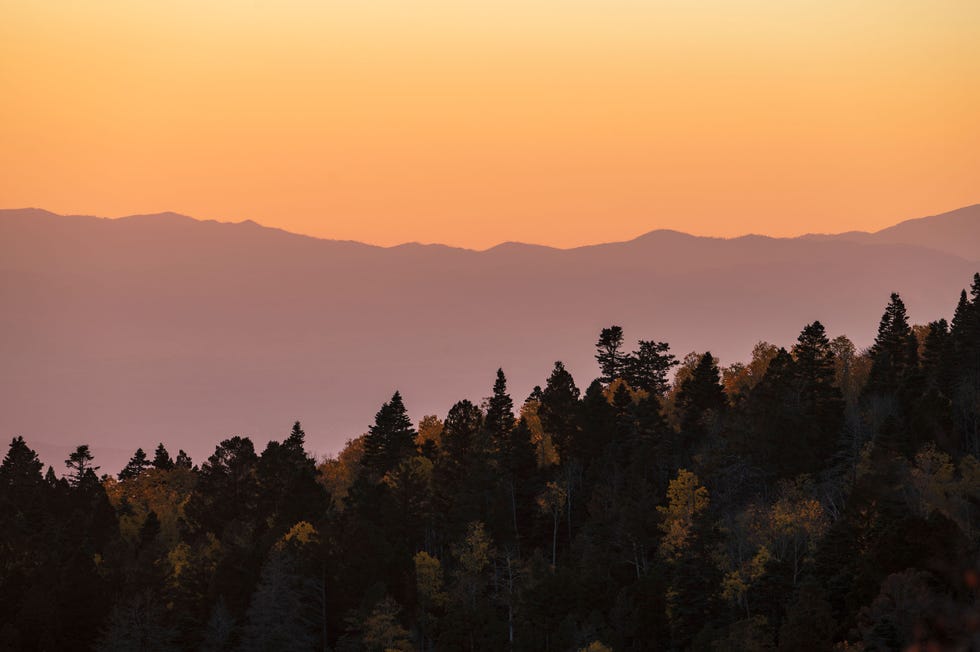
The Sangre De Cristo Mountains providing stunning views for hikers and trail runners.
Fernando Olea is the executive chef and partner at Sazon, not far from the Plaza. A larger than life native of Mexico City, he has brought the flavors of Mexico to his menu to create a scrumptious offering of New World cuisine.
Make sure that you order the sopa de amor, a cream of roasted poblanos with a lump of blue crab, topped with almond foam and dusted with cinnamon. For dessert, try the dulce sinfonia, which creates different flavors in your palette as you taste it. Think ginger caramel, avocado ice cream, piñon nut and beet sauce followed by jalapeno, as it works in stages through your tastebuds.
Olea is a master of mole poblano, a special Mexican sauce that he has created for his menu. “We pair different kinds of mole with beef or lamb, or halibut, he said, adding that “You’ll taste flavors of apricots, pecans, chocolate and more with our special recipes.”
Olea’s menu offerings, also created with the help of his chef daughter, Roberta, are some of the most unique in Santa Fe. Think octopus sauteed in olive oil with pork belly and Thai chile or shrimp enchilada with a creamy sauce of zucchini blossoms and poblano peppers and asadero cheese.
For mezcal and tequila lovers, Sazon has a remarkable menu of choices. Try one of the flights that are served with pineapple and tomato sangrita.
Every Thursday at 4 p.m., Sazon hosts one of the best tequila tastings in town called “Introduction to the Agave Spirits of Mexico.” On Fridays there is a premium Mezcal tasting, and on Saturdays, an ultra-premium agave spirits of Mexico experience. You can make a reservation for your favorite on their website Sazonsantafe.com.
While both of these restaurants will have a mix of locals and visitors, the more local spots that are on my list of regulars include La Choza, Tia Sophia’s (for lunch), Tune Up, and Harry’s Roadhouse, which is just out of town on Old Las Vegas Highway. At all of them, you’ll get great regional New Mexican-style food. If you want to come off like a local, when you are asked if you want red or green chili, just answer “Christmas,” which means both.
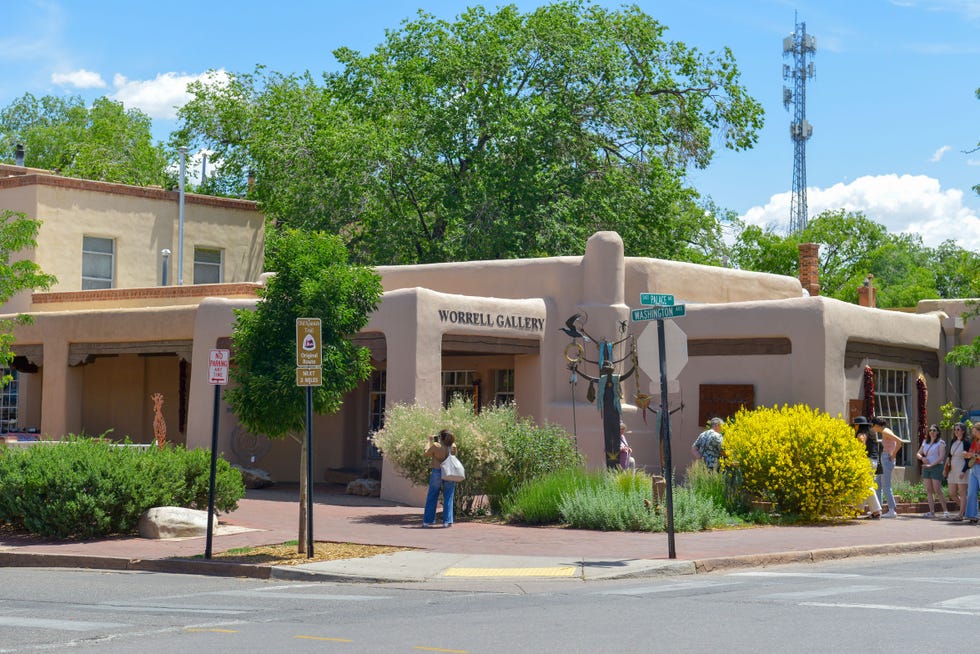
There are more than 250 art galleries in Santa Fe. And adobe buildings abound.
As for where to stay in Santa Fe, there are myriad choices. There are nearly fifty hotels in the city itself, from high end places like Bishop’s Lodge, the Inn of the Anasazi, or La Posada, to smaller, more affordable spots like SAGE, the Turquoise Bear, and The Parador, one of Emily’s favorites. But when people ask for my advice, I usually suggest renting a house through Casas de Santa Fe to become a part of the community.
As a local, you can then hang out at my favorite coffee joint, Downtown Subscription, a place that continues to be committed to having physical magazines and newspapers available. Or head to Iconik or Ohoris, both coffee spots where you can mingle with the locals over a latte.
There are endless opportunities to become a part of the Santa Fe experience, including a stay at M/E/A outside of town in Lamy in the Galisteo Basin, where those in midlife can spend a week to think about what’s next. When you are there, you may have your own epiphany and decide to pick up and move to this magical part of the world.
When you visit Santa Fe for the first time, don’t be surprised if you find yourself buying a piece of turquoise jewelry, browsing the Lucchese shop on the plaza for a pair of cowboy boots, and pulling up homes for sale on your phone. It happens to everyone.
And if you're inspired by the creative energy of the art, the creators, the galleries, and museums, and decide that you want to explore your own creativity, my advice is to go for it. For inspiration, pick up a copy of Julia Cameron’s The Artists Way: A Spiritual Path to Higher Creativity. She's a local.
When you get there, don’t be frenetic about taking it all in during one visit. Santa Fe should be all about slow travel. Absorb the smells, the tastes, the stunning landscapes, the blend of cultures, and the creativity in art and food. Once you've been, you’ll be back again and again. See you on the trails.
esquire





